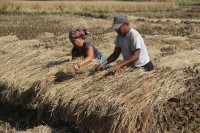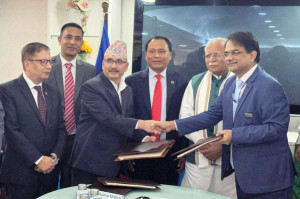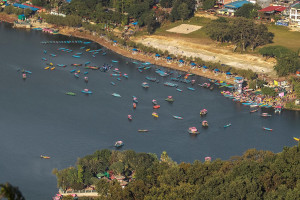Money
Domestic air passenger numbers double to 7,800 daily
Nepal’s domestic air passenger traffic has more than doubled in the last 10 years with 7,800 travellers taking to the skies daily, according to data released by Tribhuvan International Airport.
Sangam Prasain
Nepal’s domestic air passenger traffic has more than doubled in the last 10 years with 7,800 travellers taking to the skies daily, according to data released by Tribhuvan International Airport.
The year 2018 was another bumper year for domestic airlines when they flew 2.84 million passengers, up 19.22 percent from the 2017 figure. The carriers received 459,169 new flyers attracted by their low-fare schemes. Air traffic data shows that there were 1.37 million air travellers in 2009.
Traveller movement has been fluctuating since 2009 due to airfare structure and safety concerns, but the domestic airline industry went on a record breaking spree after the 2015 earthquake. Domestic passenger movement dropped to an eight-year low of 1.36 million in 2015 following the disaster that caused a severe economic downturn. But the very next year, passenger movement jumped an all-time high 28.9 percent to 1.75 million.
The sun shone brightly for domestic airlines in 2017 too, and they recorded a 39.47 percent jump in domestic air passenger movement as they expanded their fleets to cater to growing travel demand. Domestic airlines flew a record 2.45 million passengers in 2017 as travellers chose to fly rather than drive over bumpy national highways which seem to be perpetually under repair.
“Nepali consumers are very price conscious. Air seat demand increases every time airfares drop,” said Raj Kumar Chettri, general manager of Tribhuvan International Airport. “Since 2016, there has been fierce air fare wars among domestic airlines which has been attracting more flyers.”
According to Chettri, another reason for passenger growth is the affordability. “Nepalis are earning more, as a result, flying is not limited to wealthy travellers nowadays,” he said, adding that affordability would continue to drive demand and there would be an unprecedented number of Nepalis taking to the skies daily.
The rise in air seat demand has been largely induced by low fares, said Anil Manandhar, corporate manager of Shree Airlines. “Airlines have been able to maintain high load factors because of discounts. With airlines planning to add more aircraft to their fleets, low-fare schemes will continue.”
Most of the discounted tickets on offer are for off-season months like December-February and June-August, he added. Industry insiders say that airlines are offering discounts of 50 to 55 percent on the normal fare as competition intensifies to attract passengers. For example, the normal one-way airfare on the Kathmandu-Bhadrapur sector is Rs9,100, but travellers can get a ticket for as low as Rs4,000.
Airline operators said that they had been allocating more than 50 percent of their seats to budget travellers. “People are willing to pay Rs3,500 to fly from Kathmandu to Bharatpur even though they can get their in 3 hours by tourist luxury bus which costs Rs700,” said Chettri.
Tribhuvan International Airport statistics show that the flight movement of domestic airlines is nearing the 100,000 mark. In 2018, the Nepali skies saw 95,580 domestic flights, which means 262 flights take off and land daily, a majority of them at Kathmandu’s congested airport.
Chettri agrees that the growth of domestic airlines has been hampered by infrastructure hurdles. “However, we are working on every aspect to develop infrastructure.” According to him, six of the nine airports in the southern plains can now handle night flights, which will reduce congestion Tribhuvan International Airport during the daytime. “We are planning to equip more airports with technology to encourage airlines to operate night flights.”
Buddha Air topped the list in the movement of passengers in 2018. The carrier recorded a 4.45 percent growth in passenger numbers last year, flying 1.32 million passengers, the highest number for a single airline. Buddha’s rival, Yeti Airlines, saw its passenger numbers grow 20.53 percent to 668,664 in 2018.
Nepal’s largest helicopter operator, Shree Airlines, which diversified into fixed-wing services in April 2017, flew 447,877 passengers to take the third spot in terms of passenger carriage last year.
Saurya Airlines, which started operations in November 2014, carried 106,142 passengers, down 41.68 percent. Saurya Airlines has been the biggest victim of the price war. It has been grounded for the last three months after it failed to generate enough cash to pay its staff and settle dues owed to Kathmandu airport.
Nepal Airlines saw its passenger numbers drop 16.74 percent to 79,172 last year as most of its aircraft, particularly Chinese-made aircraft, remained grounded due to lack of pilots to fly them. Yeti’s subsidiary Tara Air, which only operates on remote sectors, also observed a decline of 19.94 percent in passenger movement. It flew 52 276 passengers last year.
Simrik Airlines and Summit Air (previously known as Goma Air) saw passenger numbers drop in 2018, with Simrik flying 44,522 passengers, down 31.84 percent, and Summit carrying 42,172 passengers, a drop of 0.76 percent. Sita Air flew 30,407 passengers to post a 40.51 percent jump.
Domestic airlines passenger movement
Airlines 2018 Change (in%)
Buddha Air 1,325,409 4.45
Yeti Airlines 668,664 20.53
Shree Airlines 447,877 —-
Saurya Airlines 106,142 -41.68
Nepal Airlines 79,172 -16.74
Tara Air 52,276 -19.94
Simrik Airlines 44,522 -31.84
Summit Air 42,172 -0.76
Sita Air 30,407 40.51




 16.12°C Kathmandu
16.12°C Kathmandu















